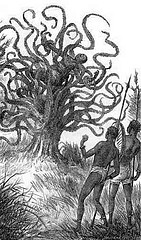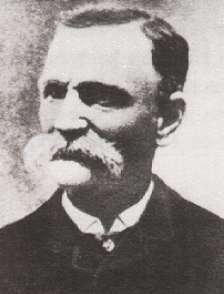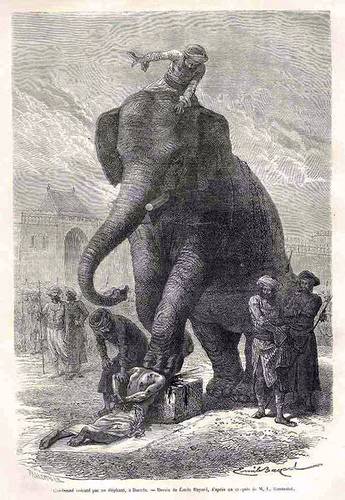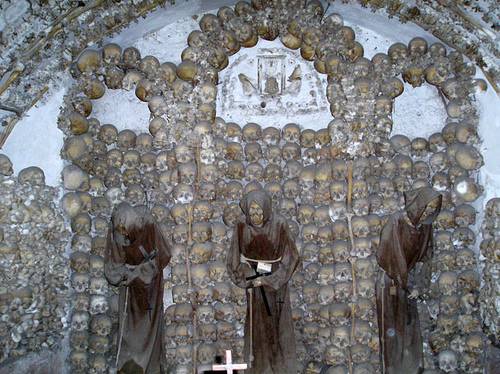In 1946, the inflation rate in Hungary reached 4.19 quintillion percent, a modern record.
By August, all the Hungarian banknotes in circulation would have bought one-thousandth of one U.S. cent.
In 1946, the inflation rate in Hungary reached 4.19 quintillion percent, a modern record.
By August, all the Hungarian banknotes in circulation would have bought one-thousandth of one U.S. cent.
Kangaroo words contain smaller versions of themselves. INDOLENT, for example, contains the letters I-D-L-E, in order. Can you find the hidden synonyms in each of these words?

Longtime readers will remember our travel advisories against Madagascar and Java, whose plants tend to eat people.
We must belatedly add Central America to that list, after reading about the ya-te-veo (“I see you”) tree in J.W. Buel’s Sea and Land (1887). That’s a pretty innocuous name, Buel writes, but it hides an evil nature: Get too close and the tree will sieze you with its shoots, press you onto its short, thick trunk, impale you with daggerlike thorns, and drink your blood.
Apologies for the late notice. If any lives have been lost due to our oversight, it’s probably best not to send flowers to the next of kin.
agelast
n. one who never laughs
The ‘Four-eyed Man of Cricklade’ was a celebrated English monstrosity of whom little reliable information is obtainable. He was visited by W. Drury, who is accredited with reporting the following–
‘So wondrous a thing, such a lusus naturae, such a scorn and spite of nature I have never seen. It was a dreadful and shocking sight.’ This unfortunate had four eyes placed in pairs, ‘one eye above the other and all four of a dull brown, encircled with red, the pupils enormously large.’ The vision in each organ appeared to be perfect. ‘He could shut any particular eye, the other three remaining open, or, indeed, as many as he chose, each several eye seeming to be controlled by his will and acting independently of the remainder. He could also revolve each eye separately in its orbit, looking backward with one and forward with another, upward with one and downward with another simultaneously.’ He was of a savage, malignant disposition, delighting in ugly tricks, teasing children, torturing helpless animals, uttering profane and blasphemous words, and acting altogether like the monster, mental and physical, that he was. ‘He could play the fiddle, though in a silly sort, having his notes on the left side, while closing the right pair of eyes. He also sang, but in a rough, screeching voice not to be listened to without disgust.’
— George M. Gould and Walter L. Pyle, Anomalies and Curiosities of Medicine, 1896

For an Old West outlaw, Black Bart had a rather poetic sensibility. Born Charles Bolles, Bart robbed stagecoaches of thousands of dollars throughout the 1870s and 1880s, but even his first victims noted his politeness — he avoided foul language and merely asked the driver to “please throw down the box.”
Eventually Bart was writing full-blown poetry to leave at the scene of each crime. He left behind this verse after one California robbery in 1877:
I’ve labored long and hard for bread,
For honor and for riches,
But on my corns too long you’ve tread
You fine-haired sons of bitches.
… and this one the following year:
Here I lay me down to sleep
To wait the coming morrow,
Perhaps success, perhaps defeat,
And everlasting sorrow.
Let come what will I’ll try it on,
My condition can’t be worse;
And if there’s money in that box
‘Tis munny in my purse.
When Bart was released from prison in 1888, a reporter asked if he were going to return to robbing stagecoaches. “No, gentlemen,” he said, “I’m through with crime.” Another asked whether he would write more poetry. He smiled, “Now, didn’t you hear me say that I am through with crime?”

Account of a torture and execution by elephant at Baroda, India, 1814:
“The man was a slave, and two days before had murdered his master, brother to a native chieftain, called Ameer Sahib. About eleven o’clock the elephant was brought out, with only the driver on his back, surrounded by natives with bamboos in their hands. The criminal was placed three yards behind on the ground, his legs tied by three ropes, which were fastened to a ring on the right hind leg of the animal. At every step the elephant took, it jerked him forward, and every eight or ten steps must have dislocated another limb, for they were loose and broken when the elephant had proceeded five hundred yards. The man, though covered in mud, showed every sign of life, and seemed to be in the most excruciating torments. After having been tortured in this manner for about an hour, he was taken to the outside of the town, when the elephant, which is instructed for such purposes, was backed, and put his foot on the head of the criminal.”
— From The Percy Anecdotes, 1821

Rome’s Capuchin Crypt contains the remains of more than 4,000 monks who died between 1528 and 1870, including several intact skeletons wearing Franciscan habits.
Reportedly it inspired the Sedlec Ossuary.
144648 = 861 × 168 = 492 × 294
185472 = 672 × 276 = 384 × 483
9949716 = 2583 × 3852 = 1476 × 6741
16746912 = 2556 × 6552 = 4473 × 3744
On Feb. 3, 1947, the Yukon’s Snag airport recorded a temperature of minus 81.4 degrees. One worker reported:
Becoming lost was of no concern. As an observer walked along the runway each breath remained as a tiny motionless mist behind him at head level. These patches of human breath fog remained in the still air for three or four minutes before fading away. One observer even found such a trail still marking his path when he returned along the same path 15 minutes later.
And: “We threw a dish of water high into the air, just to see what would happen. Before it hit the ground, it made a hissing noise, froze, and fell as tiny round pellets of ice the size of wheat kernels.”